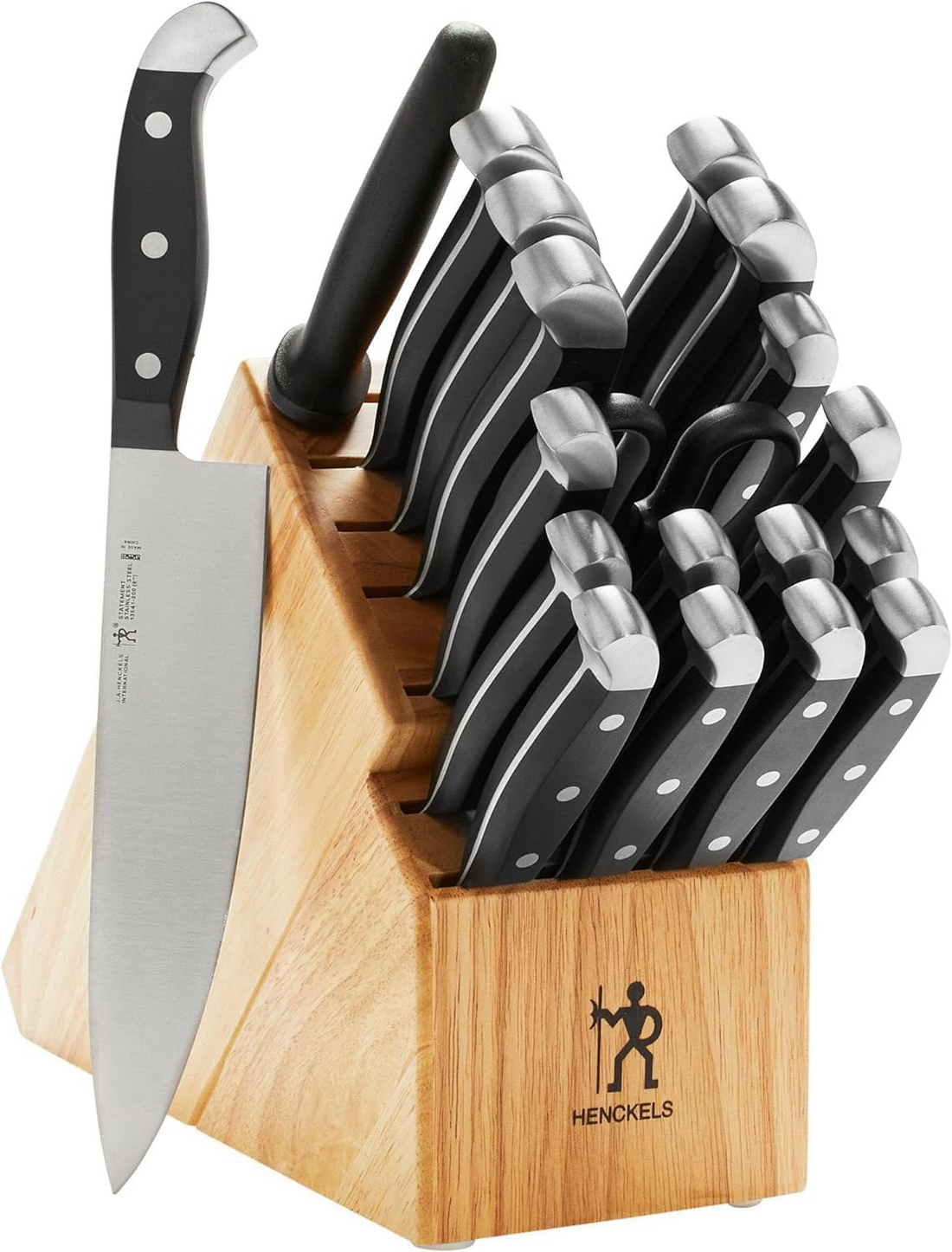The Ultimate Guide to Kitchen Knives

Share
The Ultimate Guide to Kitchen Knives: Types, Uses, Maintenance, and Safety
Kitchen knives are essential tools for every cook, whether you're a professional chef or a home cook. The right knife can transform your food preparation, making it faster, easier, and more enjoyable. This comprehensive guide covers various types of kitchen knives, their uses, materials, maintenance tips, and how to choose the perfect knife for your needs.
Types of Kitchen Knives
Chef's Knife
Description: The most versatile kitchen knife with a broad blade, usually between 6 to 12 inches long, tapering to a point.
Uses: Ideal for chopping, slicing, dicing, and mincing vegetables, fruits, and meats.
Personal Tip: This knife offers excellent control and balance for most kitchen tasks but may feel heavy for some users.
Paring Knife
Description: A small, precise knife with a blade typically 2.5 to 4 inches long.
Uses: Best for peeling, trimming, and slicing small fruits and vegetables. Perfect for tasks like deveining shrimp or seeding peppers.
Personal Tip: Lightweight and easy to handle, but it's not ideal for large tasks.
Serrated Knife
Description: Features a toothed or saw-like edge, usually 8 to 10 inches long.
Uses: Best for cutting foods with hard exteriors and soft interiors, such as bread and tomatoes.
Personal Tip: Serrated knives stay sharp longer but are difficult to sharpen and less versatile than a chef's knife.
Utility Knife
Description: A medium-sized knife, typically 4 to 7 inches long, that bridges the gap between a paring knife and a chef's knife.
Uses: Versatile for slicing fruits, vegetables, and small cuts of meat.
Personal Tip: Great for a variety of tasks but less effective for larger or heavy-duty jobs.
Boning Knife
Description: A thin, flexible blade ranging from 5 to 7 inches, designed to remove bones from meat, poultry, and fish.
Uses: Ideal for precise cuts close to the bone, perfect for deboning and filleting.
Personal Tip: Requires skill to use effectively, but it’s unbeatable for detailed cuts.
Santoku Knife
Description: A Japanese all-purpose knife with a shorter, wider blade and a flat edge, typically 5 to 7 inches long.
Uses: Great for chopping, slicing, and dicing, especially for vegetables.
Personal Tip: Lightweight with a comfortable grip, but the less curved blade makes rocking cuts less versatile.
Cleaver
Description: A large, heavy knife with a rectangular blade, often used for chopping through bones and thick meat.
Uses: Splitting bones, chopping thick cuts of meat, and crushing garlic.
Personal Tip: Very powerful but can be intimidating due to its size and weight—not ideal for precision tasks.
Fillet Knife
Description: Similar to a boning knife but typically longer and thinner, designed specifically for filleting fish.
Uses: Perfect for making delicate cuts along the bones of fish.
Personal Tip: Limited use but provides precision and flexibility when working with fish.
Blade Materials
Stainless Steel
Pros: Corrosion-resistant, durable, easy to maintain.
Cons: Can be difficult to sharpen, not as sharp as other materials.
Carbon Steel
Pros: Extremely sharp, easy to sharpen, holds an edge well.
Cons: Prone to rust and discoloration, requires more maintenance.
High-Carbon Stainless Steel
Pros: Combines the sharpness of carbon steel with the corrosion resistance of stainless steel.
Cons: More expensive and still requires maintenance.
Ceramic
Pros: Extremely sharp, lightweight, does not rust.
Cons: Brittle, can chip or break easily, difficult to sharpen.
Damascus Steel
Pros: Very sharp and strong, with unique and attractive patterns.
Cons: Expensive, requires skill to sharpen, high maintenance.
Knife Maintenance
Sharpening
Frequency: Regular sharpening is essential to maintain a sharp edge. Use a whetstone, electric sharpener, or seek professional sharpening services.
Personal Tip: Most knives need to be sharpened at a 20-degree angle, so learn the proper technique to ensure sharpness.
Honing
Purpose: Realigns the edge of the blade, keeping it sharp between sharpening sessions.
Frequency: Use a honing rod before or after each use.
Personal Tip: Honing doesn’t replace sharpening but keeps your knife in good condition for longer.
Cleaning
Method: Hand wash with warm, soapy water, then dry immediately.
Personal Tip: Avoid putting knives in the dishwasher, as it can damage both the blade and the handle.
Storage
Storage: Store knives in a knife block, on a magnetic strip, or in a protective blade guard to prevent damage.
Personal Tip: Always store your knives safely to protect the blades and prevent accidents.
Choosing the Right Knife
Purpose
Choose knives based on the tasks you perform most often. A chef’s knife is a great all-purpose tool, but you may also need a serrated knife for bread or a paring knife for detail work.
Comfort
Grip: Look for a handle that feels comfortable in your hand.
Weight: A balanced knife is easier to handle and reduces fatigue during long prep sessions.
Quality
Invest in reputable brands known for their craftsmanship. A quality knife may be more expensive, but it will last longer and perform better with proper care.
Budget
Decide whether you need a full knife set or just a few essential pieces. Investing in a few high-quality knives can be more cost-effective in the long run than buying a complete set of lower-quality knives.
Kitchen knives are indispensable tools that can significantly enhance your cooking experience. By understanding the different types of knives, their uses, and how to maintain them, you can ensure you have the right tools for every culinary task. Investing in high-quality knives and taking proper care of them will not only improve your cooking but also make it safer and more enjoyable. Whether you’re chopping vegetables, slicing meat, or filleting fish, having the right knife makes all the difference.


